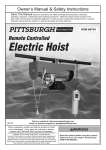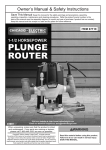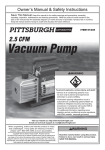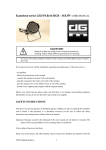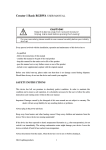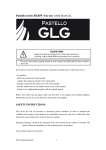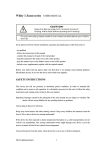Download Central Machinery 97181 Specifications
Transcript
Table of contents SAFETy Safety ......................................................... 2 Specifications ............................................. 6 Setup .......................................................... 6 Operation .................................................... 8 Maintenance .............................................. 11 Parts List and Diagram .............................. 14 Warranty .................................................... 16 WARNING SyMBOLS AND DEFINITIONS SETUp This is the safety alert symbol. It is used to alert you to potential personal injury hazards. Obey all safety messages that follow this symbol to avoid possible injury or death. Indicates a hazardous situation which, if not avoided, will result in death or serious injury. Indicates a hazardous situation which, if not avoided, could result in death or serious injury. Indicates a hazardous situation which, if not avoided, could result in minor or moderate injury. Addresses practices not related to personal injury. OpERATION IMpORTANT SAFETy INFORMATION General Tool Safety Warnings Read all safety warnings and instructions. Failure to follow the warnings and instructions may result in electric shock, fire and/or serious injury. Save all warnings and instructions for future reference. MAINTENANcE 1. KEEP GUARDS IN PLACE and in working order. 2. REMOVE ADJUSTING KEYS AND WRENCHES. Form habit of checking to see that keys and adjusting wrenches are removed from tool before turning it on. 3. KEEP WORK AREA CLEAN. Cluttered areas and benches invite accidents. 4. DON’T USE IN DANGEROUS ENVIRONMENT. Don’t use power tools in damp or wet locations, or expose them to rain. Keep work area well lighted. Page 2 5. KEEP CHILDREN AWAY. All visitors should be kept safe distance from work area. 6. MAKE WORKSHOP KID PROOF with padlocks, master switches, or by removing starter keys. 7. DON’T FORCE TOOL. It will do the job better and safer at the rate for which it was designed. 8. USE RIGHT TOOL. Don’t force tool or attachment to do a job for which it was not designed. For technical questions, please call 1-800-444-3353. Item 97181 0–6 18 16 16 14 6.1 – 10 18 16 14 12 10.1 – 12 16 16 14 12 12.1 – 16 14 12 Do not use. 9. USE PROPER EXTENSION CORD. Make sure your extension cord is in good condition. When using an extension cord, be sure to use one heavy enough to carry the current your product will draw. An undersized cord will cause a drop in line voltage resulting in loss of power and overheating. Table A shows the correct size to use depending on cord length and nameplate ampere rating. If in doubt, use the next heavier gauge. The smaller the gauge number, the heavier the cord. 10. WEAR PROPER APPAREL. Do not wear loose clothing, gloves, neckties, rings, bracelets, or other jewelry which may get caught in moving parts. Nonslip footwear is recommended. Wear protective hair covering to contain long hair. 11. ALWAYS USE SAFETY GLASSES. Also use face or dust mask if cutting operation is dusty. Everyday eyeglasses only have impact resistant lenses, they are NOT safety glasses. 15. DISCONNECT TOOLS before servicing; when changing accessories, such as blades, bits, cutters, and the like. 16. REDUCE THE RISK OF UNINTENTIONAL STARTING. Make sure switch is in off position before plugging in. 17. USE RECOMMENDED ACCESSORIES. Consult the owner’s manual for recommended accessories. The use of improper accessories may cause risk of injury to persons. 18. NEVER STAND ON TOOL. Serious injury could occur if the tool is tipped or if the cutting tool is unintentionally contacted. 19. CHECK DAMAGED PARTS. Before further use of the tool, a guard or other part that is damaged should be carefully checked to determine that it will operate properly and perform its intended function – check for alignment of moving parts, binding of moving parts, breakage of parts, mounting, and any other conditions that may affect its operation. A guard or other part that is damaged should be properly repaired or replaced. 20. DIRECTION OF FEED. Feed work into a blade or cutter against the direction of rotation of the blade or cutter only. 21. NEVER LEAVE TOOL RUNNING UNATTENDED. TURN POWER OFF. Don’t leave tool until it comes to a complete stop. MAINTENANcE 12. SECURE WORK. Use clamps or a vise to hold work when practical. It’s safer than using your hand and it frees both hands to operate tool. 14. MAINTAIN TOOLS WITH CARE. Keep tools sharp and clean for best and safest performance. Follow instructions for lubricating and changing accessories. SAFETy (at full load) EXTENSION cORD LENGTH 25′ 50′ 100′ 150′ SETUp NAMEpLATE AMpERES 13. DON’T OVERREACH. Keep proper footing and balance at all times. OpERATION Table A: REcOMMENDED MINIMUM WIRE GAUGE FOR EXTENSION cORDS (120 VOLT) Item 97181 For technical questions, please call 1-800-444-3353. Page 3 Grounding Instructions SAFETy TO pREVENT ELEcTRIc SHOcK AND DEATH FROM INcORREcT GROUNDING WIRE cONNEcTION READ AND FOLLOW THESE INSTRUcTIONS: 110-120 V~ Grounded Tools: Tools with Three prong plugs 1. In the event of a malfunction or breakdown, grounding provides a path of least resistance for electric current to reduce the risk of electric shock. This tool is equipped with an electric cord having an equipment-grounding conductor and a grounding plug. The plug must be plugged into a matching outlet that is properly installed and grounded in accordance with all local codes and ordinances. SETUp 2. Do not modify the plug provided – if it will not fit the outlet, have the proper outlet installed by a qualified electrician. 3. Improper connection of the equipment-grounding conductor can result in a risk of electric shock. The conductor with insulation having an outer surface that is green with or without yellow stripes is the equipment-grounding conductor. If repair or replacement of the electric cord or plug is necessary, do not connect the equipmentgrounding conductor to a live terminal. OpERATION 4. Check with a qualified electrician or service personnel if the grounding instructions are not completely understood, or if in doubt as to whether the tool is properly grounded. 5. Use only 3-wire extension cords that have 3-prong grounding plugs and 3-pole receptacles that accept the tool’s plug. 6. Repair or replace damaged or worn cord immediately. Grounding pin 125 V~ 3-prong plug and Outlet (for up to 125 V~ and up to 15 A) 7. This tool is intended for use on a circuit that has an outlet that looks like the one illustrated above in 125 V~ 3-prong plug and Outlet. The tool has a grounding plug that looks like the plug illustrated above in 125 V~ 3-prong plug and Outlet. 8. The outlet must be properly installed and grounded in accordance with all codes and ordinances. 9. Do not use an adapter to connect this tool to a different outlet. Sander Safety Warnings For y your Own Safety Read Instruction Manual Before Operating Sander 1. Wear eye protection. 2. Support workpiece with miter gauge, backstop, or worktable. MAINTENANcE 3. Maintain 1/16 inch maximum clearance between table and sanding belt or disc. 4. Avoid kickback by sanding in accordance with the directional arrows. 5. The backstop is a fence near the surface that helps the operator maintain control of the workpiece and prevents the workpiece from being pulled into the machine. For safety, it must be adjusted very close to the sanding surface. Page 4 6. The worktable is the surface mounted close to the sanding surface that the operator rests the workpiece against to prevent it from being pulled adjusted very close to the sanding surface. 7. The sanding belt is designed to rotate down towards the table while the disc rotates both up from the table and down towards the table. Sand on the belt with the workpiece in front of the backstop and/or table. Sand only on the downward moving surface of the disc - sanding on the upward moving surface may result in the workpiece being thrown up and towards the operator. 8. Remove Safety Key when the Switch is turned off. Do not leave the Safety Key in the Switch when the tool is not in use. For technical questions, please call 1-800-444-3353. Item 97181 12. Only use safety equipment that has been approved by an appropriate standards agency. Unapproved safety equipment may not provide adequate protection. Eye protection must be ANSI-approved and breathing protection must be NIOSH-approved for the specific hazards in the work area. 13. Stay alert, watch what you are doing and use common sense when operating a power tool. Do not use a power tool while you are tired or under the influence of drugs, alcohol or medication. A moment of inattention while operating power tools may result in serious personal injury. 14. Industrial applications must follow OSHA guidelines. 15. Maintain labels and nameplates on the tool. These carry important safety information. If unreadable or missing, contact Harbor Freight Tools for a replacement. 16. Avoid unintentional starting. Prepare to begin work before turning on the tool. 17. People with pacemakers should consult their physician(s) before use. Electromagnetic fields in close proximity to heart pacemaker could cause pacemaker interference or pacemaker failure. 19. Your risk from these exposures varies, depending on how often you do this type of work. To reduce your exposure to these chemicals: work in a well ventilated area, and work with approved safety equipment, such as those dust masks that are specially designed to filter out microscopic particles. (California Health & Safety Code § 25249.5, et seq.) 20. WARNING: Handling the cord on this product will expose you to lead, a chemical known to the State of California to cause cancer, and birth defects or other reproductive harm. Wash hands after handling. (California Health & Safety Code § 25249.5, et seq.) 21. The warnings, precautions, and instructions discussed in this instruction manual cannot cover all possible conditions and situations that may occur. It must be understood by the operator that common sense and caution are factors which cannot be built into this product, but must be supplied by the operator. Vibration Safety 1. Anyone using vibrating tools regularly or for an extended period should first be examined by a doctor and then have regular medical check-ups to ensure medical problems are not being caused or worsened from use. Pregnant women or people who have impaired blood circulation to the hand, past hand injuries, nervous system disorders, diabetes, or Raynaud’s Disease should not use this tool. If you feel any medical or physical symptoms related to vibration (such as tingling, numbness, and white or blue fingers), seek medical advice as soon as possible. 2. Do not smoke during use. Nicotine reduces the blood supply to the hands and fingers, increasing the risk of vibration-related injury. 3. Use tools with the lowest vibration when there is a choice between different processes. 4. Include vibration-free periods each day of work. 5. Grip tool as lightly as possible (while still keeping safe control of it). Let the tool do the work. 6. To reduce vibration, maintain the tool as explained in this manual. If any abnormal vibration occurs, stop use immediately. MAINTENANcE This tool vibrates during use. Repeated or long-term exposure to vibration may cause temporary or permanent physical injury, particularly to the hands, arms and shoulders. To reduce the risk of vibration-related injury: SAVE THESE INSTRUcTIONS. Item 97181 SAFETy 11. When servicing use only identical replacement parts. SETUp 10. The use of accessories or attachments not recommended by the manufacturer may result in a risk of injury to persons. 18. WARNING: Some dust created by power sanding, sawing, grinding, drilling, and other construction activities, contains chemicals known [to the State of California] to cause cancer, birth defects or other reproductive harm. Some examples of these chemicals are: • Lead from lead-based paints • Crystalline silica from bricks and cement or other masonry products • Arsenic and chromium from chemically treated lumber OpERATION 9. DO NOT OpERATE WITH ANy y GUARD DISABLED, DAMAGED, OR REMOVED. Moving guards must move freely and close instantly. For technical questions, please call 1-800-444-3353. Page 5 Specifications SAFETy Electrical Rating 120V~ / 60Hz / 3.5A Belt Size 4" W x 36" L Disc Size 6" Max. Speed 1819 RPM (Disc) 1185 FPM (Belt) Setup - Before Use: Read the ENTIRE IMpORTANT SAFETy y INFORMATION section at the beginning of this manual including all text under subheadings therein before set up or use of this product. SETUp TO pREVENT REVENT SERIOUS INJUR INJURy y FROM AccIDENTAL OpERATION: Turn the power ower Switch of the tool off and unplug the tool from its electrical outlet before performing any procedure in this section. Note: For additional information regarding the parts listed in the following pages, refer to the Assembly Diagram near the end of this manual. Assembly/Mounting Mounting Backing Disc 1. Carefully set the Belt/Disc Sander on its side. 1. Set the Belt/Disc Sander on its feet. 2. Press Rubber Feet (28) over the four corner lips of the Base. See Figure A. 2. Slide the Backing Disc (5) onto the Drive Axle (54). The Set Screw (6) must face the flat surface of the Drive Axle (54). See Figure B. OpERATION Feet placement Set Screw (6) MAINTENANcE Rubber Feet (28) Figure A Drive Axle (54) Backing Disc (5) Figure B 3. Tighten the Set Screw (6) securely. Page 6 For technical questions, please call 1-800-444-3353. Item 97181 Mounting Fence Machine Screws 1. The Fence (63) fits across the top of the sanding belt to prevent workpiece from moving to the rear when sanding. SAFETy 2. Align two Tabs on the Fence (63) with two Holes on the top of the Belt End Guard (58). Place Fence tabs underneath the Belt End Guard (58). Insert two Machine Screws through Flat Washers and into Holes. Thread Machine Screws into the Tabs on the Fence (63). Note: Use Flat Washers between screw heads and Belt End Guard (58). See Figure c. 3. Bolt the Fence (63) to the Belt Support Housing (52) using Bolt (32), Flat Washer (26), and Lock Washer (27). Fence (63) Tabs (not shown) are underneath Belt End Guard (58) where Machine Screws are shown. Functions Belt Alignment Knob Sanding Belt Fence OpERATION Sanding Disc Belt Tension Handle SETUp Figure c Table Miter Gauge Supporting Shaft Angle Adjusting Knob Figure D Safety Switch Insert the Safety Key into the Switch. This “Key” is a safety precaution and should remain in the Switch during use and be removed after Switch (31) is turned off and/or any time the Belt/Disc Sander is left unattended or in storage. Item 97181 For technical questions, please call 1-800-444-3353. Page 7 MAINTENANcE Switch with Safety Key Operating Instructions Read the ENTIRE IMpORTANT SAFETy y INFORMATION section at the beginning of this manual including all text under subheadings therein before set up or use of this product. SAFETy Tool Set Up TO pREVENT REVENT SERIOUS INJUR INJURy y FROM AccIDENTAL OpERATION: Turn the power ower Switch of the tool off and unplug the tool from its electrical outlet before performing any procedure in this section. TO pREVENT REVENT SERIOUS INJUR INJURy: DO NOT OpERATE WITH ANy y GUARD DISABLED, DAMAGED, OR REMOVED. Mounting Table for Use as Disc Sander NOTE: The Table (69) may be used as support for both horizontal and vertical applications. SETUp 1. Insert the end of Table Bar (72) with Pivot Indicator (70) into the Bar Holder (74). See Figure E. pivot Indicator (70) Tighten two Set Screws (6) OpERATION Bolt (71), Flat Washer (26) and Lock Washer (27) Table Bar (72) Angle Adjusting Knob (75) Table (69) Flat Washer (26) Bar Holder (74) Figure E pivot Indicator (70) MAINTENANcE 2. Insert free end of Table Bar (72) into two Mounting Supports on bottom of Table (69). Tighten the two Set Screws. See Figure E on page 8. Figure F 6. Slide the Supporting Shaft (76) into Bar Holder (74). Align the flat face of the Supporting Shaft with Set Screws and tighten securely. See Figure G. 7. Slide the Supporting Shaft (76) into the hole on side of Machine Body (33) and tighten Bolt (32). See Figure D on page 7. Bar Holder (74) 3. Mount the Pivot Indicator (70) tab to the Table (69) using a Hex Bolt (71), Flat Washer (26) and Lock Washer (27). See Figure F. 4. Mount Pivot Indicator (70) to the Bar Holder (74) using the Angle Adjusting Knob (75) and Flat Washer (26). Finger tighten. See Figure E and Figure F. 5. Tighten all fasteners. Make sure the Pivot Indicator (70) operates smoothly when the Angle Adjusting Knob (75) is loosened. Page 8 Supporting Shaft Flat Side (76) Figure G For technical questions, please call 1-800-444-3353. Item 97181 NOTE: The Table (69) may be used for both horizontal and vertical operations. 1. Remove Table from Machine Body (33) by loosening Bolt (32) and sliding Supporting Shaft (76) out. Supporting Rod (23) Nut (22) 2. Set Belt/Disc Sander in vertical position by loosening both Nuts (22). Raise the Belt Support Housing (52). When it is vertical, wrench tighten both Nuts (22) securely to prevent the Belt Support Housing (52) from slipping. See Figure H. 3. Insert Supporting Shaft (76) into the hole facing the belts and tighten Bolt (32) against flat side of Supporting Shaft (76). See Figure I. SAFETy Mounting Table for Use as Belt Sander SETUp Belt Sander (62) Table (69) Disc cover (8) Figure H Figure I Leveling the Table 1. Loosen the Angle Adjusting Knob (75) on the Pivot Indicator (70). Place a combination square (not supplied) on the Table (69) so that the combination square touches the sanding disc. If the Table is 90° to the sanding disc, the table is level. Always maintain a maximum of 1/16" clearance between the Table and the Sanding Disc. Tighten the Angle Adjusting Knob. 2. If the Table is not 90° to the sanding disc pad, loosen the Angle Adjusting Knob and tilt the Table until it is square with the sanding disc. Tighten the Angle Adjusting Knob. 3. Loosen Screw (29) holding the Angle Pointer (73) and adjust it to point to 90°. Tighten the Screw. MAINTENANcE NOTE: For these instructions and “General Operating Instructions” on following pages, refer to Figure c on page 7 of this manual. Adjusting the Sanding Belt Tracking 1. With the Belt/Disc Sander turned off, manually move the Sanding Belt. Item 97181 OpERATION Outer pulley cover (9) 2. If the belt starts moving to the side of either roller, it needs to be adjusted. For technical questions, please call 1-800-444-3353. Page 9 3. Turn the Belt Adjustment Knob (49) until the belt rides the center of the Rear Roller (56) and the Front Roller (44). 4. Move the Sanding Belt manually after adjustment to assure proper alignment. Mounting Sanding Discs SAFETy NOTE: Before using the Sanding Disc the first time, wipe down the Backing Disc with denatured alcohol (shellac thinner). This will clean the surface, leave no residue and assure a secure bond. 1. Remove the Table (69) if it is mounted in front of the Sanding Disc. 2. Peel off old Sanding Disc. 3. Align perimeter of new Sanding Disc over the Backing Disc (5) and press firmly onto the Backing Disc. Workpiece and Work Area Set Up 1. Designate a work area that is clean and well lit. The work area must not allow access by children or pets to prevent distraction and injury. SETUp 2. Route the power cord along a safe route to reach the work area without creating a tripping hazard or exposing the power cord to possible damage. The power cord must reach the work area with enough extra length to allow free movement while working. 3. Secure loose workpieces using a vise or clamps (not included) to prevent movement while working. 4. There must not be objects, such as utility lines, nearby that will present a hazard while working. General Operating Instructions 1. Make sure that the Switch is in the offoff position, then plug in the tool. 2. Insert Safety Key into Switch. 3. Make sure nothing is contacting the Sanding Disc or Belt, then turn on the Switch. OpERATION 4. When using the Disc Sander, only use the LEFT side of the Sanding Disc (as you face it) to sand. The Sanding Disc turns counterclockwise and using the right side could cause kickback. 5. Use two hands and hold workpiece securely against the fence/table at all times. Press the workpiece against the belt/disc to start sanding. Keep the workpiece moving for a better finish. 6. After use, turn off the tool, remove the Safety Key from the Switch, and disconnect from the power supply. Clean and store the tool indoors out of children's reach. MAINTENANcE Page 10 For technical questions, please call 1-800-444-3353. Item 97181 Maintenance and Servicing SAFETy procedures not specifically explained in this manual must be performed only by a qualified technician. TO pREVENT REVENT SERIOUS INJUR INJURy y FROM AccIDENTAL OpERATION: Turn the power ower Switch of the tool off and unplug the tool from its electrical outlet before performing any procedure in this section. TO pREVENT REVENT SERIOUS INJUR INJURy y FROM TOOL FAILURE: Do not use damaged equipment. If abnormal noise or vibration occurs, have the problem corrected before further use. • loose hardware, • misalignment or binding of moving parts, • cracked or broken parts, • damaged electrical wiring, and • any other condition that may affect its safe operation. 4. Apply a light coat of paste wax to the Table to make feeding material easier. 5. Use compressed air to blow dust and debris from the Sander and Motor. 6. The Bearings on this Sander are sealed and do not require lubrication. 7. WARNING! If the supply cord of this power tool is damaged, it must be replaced only by a qualified service technician. MAINTENANcE 2. AFTER USE, turn off the tool, remove the Safety Key from the Switch, and disconnect its power supply. Then, wipe external surfaces of the tool with clean cloth. 3. A Dust Port (59) is located on the bottom of the Lower Guard Plate (60). It is held in place with a Screw (61) and can be removed for vacuuming collected dust and sanding residue. Replace the Dust Port after cleaning and tighten Screw. OpERATION 1. BEFORE EAcH USE, inspect the general condition of the tool. Check for: SETUp cleaning, Maintenance, and Lubrication Item 97181 For technical questions, please call 1-800-444-3353. Page 11 Sanding Belt Replacement SAFETy 1. Push the Belt Tension Handle (50) forward to loosen the belt. 6. Slide a new Sanding Belt onto Front and Rear Rollers. 2. Remove Upper Guard Plate (58) by unscrewing four Screws (7). 7. Replace the Lower Guard Plate and tighten the four Screws securely. 3. Remove the Lower Guard Plate (60) by unscrewing the four Screws (7) that hold it to the Belt Support Housing (52). 8. Replace the Upper Guard Plate and tighten the four Screws. 4. Slide the old Sanding Belt off the Rear Roller (56) and Front Roller (44). 5. Replace with a 4" X 36" Sanding Belt with the correct grit for the project you are working on. Note: The larger the grit number, the smaller the grain. Use small numbered grits for cutting and larger for smoothing and finishing. 9. Push the Belt Tension Handle to the rear to tighten the belt. 10. Before using, manually check the new belt for alignment. See instructions in the “General Operating” section of this manual. SETUp V-Belt Replacement 1. Remove Set Screws (6) and pull off Backing Disc (5). 2. Remove four Screws (11) and Washers (10) from Outer Pulley Cover (9). 3. Once the Outer Pulley Cover is removed, the V-Belt (12) is accessible. OpERATION 4. Remove the V-Belt using a flat screwdriver (not supplied). Place the tip of the screwdriver between the Motor Pulley (13) and the V-Belt while turning the V-Belt by hand. As it turns, the V-Belt will ride up and out of the Motor Pulley groove. Once off the Motor Pulley, lift the V-Belt off of the Spindle Pulley (14). 5. Place the new V-Belt (12) onto the Spindle Pulley, by using a flat screwdriver (not supplied) as a wedge. Turn the Spindle Pulley and ride the new V-Belt onto the Motor Pulley. 6. Replace Outer Pulley Cover. Tighten Screws and Washers. WARNING! If the supply cord of this power tool is damaged, it must be replaced only by a qualified service technician. V-Belt Tensioning 1. Remove Set Screws (6) and pull off Backing Disc (5). 2. Remove four Screws (11) and Washers (10) from Outer Pulley Cover (9). MAINTENANcE 3. Loosen four motor mount Nuts (22) and slide the Motor (40) further forward towards Front Roller (44), making sure to pull evenly on the motor. While holding the Motor in its current position, tighten the Nuts. Page 12 4. Place a straight edge on the faces of the two pulleys to ascertain alignment. Contact surfaces of the pulleys and the straight edge must fully touch. Fully tighten the Nuts. 5. Replace Outer Pulley Cover and tighten Screws and Washers. Replace Backing Disc and tighten Set Screws. For technical questions, please call 1-800-444-3353. Item 97181 Troubleshooting possible causes Belt/Disc Sander 1. Not plugged in. does not turn on 2. No power at outlet. 3. Safety Key not inserted into Switch. 4. Switch is not turned “ON”. Motor slows 1. V-Belt too tight. when sanding 2. Applying too much pressure while sanding Wood burns 1. Sanding disc or belt may be while sanding loaded with dirt or debris. 2. Too much pressure. 1. 2. 3. 4. 1. 2. Likely Solutions Plug in Sander. Check power at outlet and/or circuit breaker. Insert Safety Key into Switch. Turn on the Switch. Have the V-Belt adjusted by a qualified technician. Use less pressure. SAFETy problem 1. Clean or replace disc or belt using instructions in this manual. 2. Use less pressure. MAINTENANcE OpERATION SETUp Follow all safety precautions whenever diagnosing or servicing the tool. Disconnect power supply before service. Item 97181 For technical questions, please call 1-800-444-3353. Page 13 parts List and Diagram pLEASE READ THE FOLLOWING cAREFULLy AREFULL AREFULLy SAFETy THE MANUFACTURER AND/OR DISTRIBUTOR HAS PROVIDED THE PARTS LIST AND ASSEMBLY DIAGRAM IN THIS MANUAL AS A REFERENCE TOOL ONLY. NEITHER THE MANUFACTURER OR DISTRIBUTOR MAKES ANY REPRESENTATION OR WARRANTY OF ANY KIND TO THE BUYER THAT HE OR SHE IS QUALIFIED TO MAKE ANY REPAIRS TO THE PRODUCT, OR THAT HE OR SHE IS QUALIFIED TO REPLACE ANY PARTS OF THE PRODUCT. IN FACT, THE MANUFACTURER AND/OR DISTRIBUTOR EXPRESSLY STATES THAT ALL REPAIRS AND PARTS REPLACEMENTS SHOULD BE UNDERTAKEN BY CERTIFIED AND LICENSED TECHNICIANS, AND NOT BY THE BUYER. THE BUYER ASSUMES ALL RISK AND LIABILITY ARISING OUT OF HIS OR HER REPAIRS TO THE ORIGINAL PRODUCT OR REPLACEMENT PARTS THERETO, OR ARISING OUT OF HIS OR HER INSTALLATION OF REPLACEMENT PARTS THERETO. parts List part SETUp OpERATION MAINTENANcE 1 2 3 4 5 6 7 8 9 10 11 12 13 14 15 16 17 18 19 20 21 22 23 24 25 26 27 28 29 30 31 32 33 34 35 36 37 38 Description Screw M4 X 12 Flat Washer Front Cover Sanding Disc Backing Disc Screw M8 X 8 Set Screw M4 X 8 Disc Cover Outer Pulley Cover Washer Screw M4 X 8 V-Belt Motor Pulley Spindle Pulley Screw M8 X 6 Bolt M6 X 12 Lock Washer Flat Washer Screw M5 X 20 Inner Pulley Cover Spacer Nut 8 Supporting Rod Nut Base Flat Washer 8 Lock Washer 8 Rubber Foot Screw M5 X 12 Flat Washer 5 Switch Bolt M8 X 16 Housing Rubber Pad Steel Plate Holding Plate Cable Fixing Plate Grommet Qty 9 27 1 1 1 6 14 1 1 16 6 1 1 1 2 6 7 7 3 1 1 6 1 1 1 9 8 4 5 5 1 8 1 1 1 1 1 1 part 39 40 41 42 43 44 45 46 47 48 49 50 51 52 53 54 55 56 57 58 59 60 61 62 63 64 65 66 67 68 69 70 71 72 73 74 75 76 Description Power Cord Motor Washer 5 Retaining Ring 12 Ball Bearing Front Roller Adjusting Bracket Spring Shaft Spring Belt Adjustment Knob Belt Tension Handle Screw M6 X 12 Belt Support Housing Carriage Bolt M8 X 35 Drive Axle Bearing Housing Rear Roller Left Bearing Housing Belt End Guard Dust Port Lower Guard Plate Screw Sanding Belt Fence Knob M5 X 16 Miter Gauge Screw M5 X 6 Miter Pointer Sliding Bar Table Pivot Indicator Hex Bolt M8 X 10 Table Bar Angle Pointer Bar Holder Angle Adjusting Knob Supporting Shaft Qty 1 1 4 2 4 1 1 1 1 1 1 1 1 1 2 1 1 1 1 1 1 1 3 1 1 1 1 1 1 1 1 1 1 1 1 1 1 1 Record product’s Serial Number Here: Note: If product has no serial number, record month and year of purchase instead. Note: Some parts are listed and shown for illustration purposes only, and are not available individually as replacement parts. Page 14 For technical questions, please call 1-800-444-3353. Item 97181 MAINTENANcE OpERATION SETUp SAFETy Assembly Diagram Item 97181 For technical questions, please call 1-800-444-3353. Page 15 Limited 90 Day Warranty Harbor Freight Tools Co. makes every effort to assure that its products meet high quality and durability standards, and warrants to the original purchaser that this product is free from defects in materials and workmanship for the period of 90 days from the date of purchase. This warranty does not apply to damage due directly or indirectly, to misuse, abuse, negligence or accidents, repairs or alterations outside our facilities, criminal activity, improper installation, normal wear and tear, or to lack of maintenance. We shall in no event be liable for death, injuries to persons or property, or for incidental, contingent, special or consequential damages arising from the use of our product. Some states do not allow the exclusion or limitation of incidental or consequential damages, so the above limitation of exclusion may not apply to you. THIS WARRANTY IS EXPRESSLY IN LIEU OF ALL OTHER WARRANTIES, EXPRESS OR IMPLIED, INCLUDING THE WARRANTIES OF MERCHANTABILITY AND FITNESS. To take advantage of this warranty, the product or part must be returned to us with transportation charges prepaid. Proof of purchase date and an explanation of the complaint must accompany the merchandise. If our inspection verifies the defect, we will either repair or replace the product at our election or we may elect to refund the purchase price if we cannot readily and quickly provide you with a replacement. We will return repaired products at our expense, but if we determine there is no defect, or that the defect resulted from causes not within the scope of our warranty, then you must bear the cost of returning the product. This warranty gives you specific legal rights and you may also have other rights which vary from state to state. 3491 Mission Oaks Blvd. • PO Box 6009 • Camarillo, CA 93011 • (800) 444-3353

















